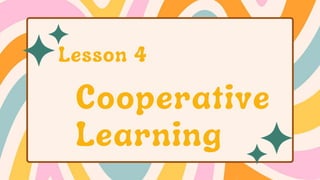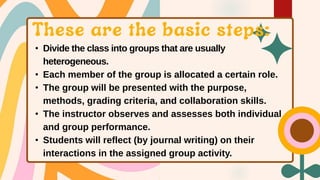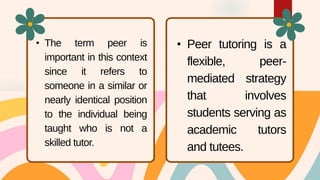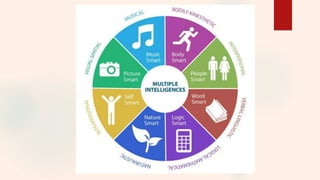Multi Grade Lesson 4 Lesson 5 Lesson 6-7.pptx
- 3. Ms. De la Cruz, the adviser of a multigrade class of pupils in grades 4, 5, and 6, has been using whole class instruction for several days in a row. She noted that the majority of the grade 6 students were uninterested in the conversation, some of the grade 5 children were making noise, and the grade 4 students were having difficulty grasping the subject. There is a lot of noise in the classroom, and the lesson is no longer interesting to them. She is saddened because she believes she is failing to give her learners engaging learning opportunities.
- 4. • •
- 5. Cooperative learning strategies are used to facilitate the creation of a positive, supportive classroom climate. Cooperative Learning is a teaching style in which students work together to achieve common goals. Cooperative learning groups are formed and assignments are designed in such a way that learners must collaborate to achieve a goal, solve an issue, make a decision, or create a product. This type of learning encourages social connection, positive self- esteem development, and increased acceptance and supporting actions among group members.
- 6. The seating arrangement in the classroom should be designed to enhance group cooperation.
- 7. • Students must be aware of their group members' shared responsibilities through task division. Team roles such as facilitator, recorder, checker, spokesperson, time keeper, and others must be defined for everyone. Incentivize students to take on given tasks with accountability for group learning by offering rewards for success.
- 8. • Ensure that each group member understands the goal and processes of the assigned work. Each group is made up of students of varying abilities: high, average, and low performers.
- 9. • 1.Think, Pair and Share • 2. Jigsaw Puzzle • 3. Small Mixed Group Activity
- 10. In this type of cooperative learning, learners think for themselves about a certain topic assigned by the teacher. They then form groups with another student to discuss it, and present their findings to the full class.
- 11. What is the problem, question, or subject? What are my thoughts about it? What is my partner's opinion? What will we share?
- 12. Method of teaching is a collection of themes that students will fully develop before coming together to form a whole idea, similar to how a jigsaw puzzle is a collection of different pieces that come together to form a complete picture.
- 13. • Divide the class into groups. • Assign a leader to each group; • Divide the lesson into portions based on the number of groups; and • Assign one part to each leader to read and learn. • Create temporary "expert groups" by bringing one student from each jigsaw group together with other students allocated to the same segment. • Return the students to their jigsaw groups. • Request that each student give his or her part to the class.
- 14. This cooperative method allows students to collaborate to complete a collaborative job or assignment that will be shared with the entire class.
- 15. • Divide the class into groups that are usually heterogeneous. • Each member of the group is allocated a certain role. • The group will be presented with the purpose, methods, grading criteria, and collaboration skills. • The instructor observes and assesses both individual and group performance. • Students will reflect (by journal writing) on their interactions in the assigned group activity.
- 21. "Mae has trouble finishing her activity by herself. She makes drawings in her notebook, gets out of her seat to talk with her classmates or cries when she can't finish her activity". "Kim takes a long time to read and has trouble understanding what she reads. She understands better when she reads with a friend". "I care about my pupils and I want to assist them one-on-one. But my hands are full of overlapping activities in the classroom".
- 22. Can teachers provide each of the children the extra time and help required to bring them to mastery in the specific skills they need? Who can help the teacher in the classroom? What is the available method of providing one- on-one help needed?
- 23. The definitive description of peer tutoring is "a method of education in which pupils assist each other and study by themselves.
- 24. • The term peer is important in this context since it refers to someone in a similar or nearly identical position to the individual being taught who is not a skilled tutor. • Peer tutoring is a flexible, peer- mediated strategy that involves students serving as academic tutors and tutees.
- 25. Typically, a higher performing student is paired with a lower performing student to review critical academic or behavioral concepts. Its goal is to create self-managed learners with high self-esteem
- 26. • 1.Same-age peer tutoring • 2.Cross-age peer tutoring • 3.Class-wide peer tutoring
- 27. • This is an approach wherein one child instructs another child on materials on wherein the first is an expert and the second is a novice.
- 28. • To teach or review a skill, older students are paired with younger students. The roles of tutor and tutee remain unchanged.
- 29. The older student acts as the tutor, while the younger student serves as the tutee. The older and younger students' skill levels may be fairly similar, with the relationship being one of cooperative or expert engagement. Tutors help to model right behavior, ask questions, and promote better study habits
- 30. • This is based on reciprocal peer tutoring and group reinforcement, in which a full classroom of students actively participates in the process of simultaneously acquiring and practicing basic academic abilities.
- 31. Learners perceive tutors who are their peers since they are cognitively and socially connected.
- 32. It is a successful method of enhancing student achievement, particularly for students who are at risk of dropping out or who have been identified as having poor academic learning performance. Many kids perform better in brief and structured peer tutoring programs.
- 33. Students benefit academically from practice and in peer language that is understandable to them. It improves tutor-tutee discipline, self- esteem, cooperation, and peer relationships.
- 34. Determine the learner's individual skill for each subject that requires development.
- 35. Create a schedule for the peer tutoring activity and identify tutors and tutees ahead of time. Provide explicit instructions on what and how to execute the identified activity, who to tutor, and how to deal with the tutee. The teacher must effectively guide and monitor tutors.
- 36. Plan learning assignments that begin at the learners' basic level of ability and progress to more advanced ones.. Provide tutoring activity feedback and keep a record of the student's activities.
- 37. Spelling Subject Date & Time Thursday Tuesday 4:00-4:30 PM Wednesday 4:00-4:30 PM Reading Mathematics Learning Task Spell words correctly, (Set 4 Long a : a-e pattern). Improve reading of sight words and vocabulary (Set 2). Mastery of the Multiplication Facts (Table 3) Tutor Beth (Gr.2) Annie (Gr. 3) Jesse (Gr. 3) Tutee Karen (Gr. 1) Ken (Gr.1) Trex (Gr.2) Materials Envelope: -word cards with pictures (e.g gate) -words cards with missing letters of the words -tutee’s worksheet Envelope: words cards of sight words -cut-out letters -tutee’s worksheet Envelope: -flash cards -lego blocks -tutee’s worskheet
- 38. Spelling Subject Procedure Present the peer tutoring routines to be followed: -Review the phonetic sounds of the letters. -Present the sight words. -Say the clearly the phonetic sound of every letter in the word. -Let the tutee say/read the word. -Say ‘very good’ if the tutee reads the word correctly; if not read correctly by the word again. Present the peer tutoring routines to be followed: -Present the multiplication fact of table 3 (e.g 2x3=6). -Illustrate the multiplication concept using the lego blocks (2 groups of 3 lego blocks). -Let the tutee complete the multiplication table 3 facts in the work-sheet. -Proceed to the nect multiplication concept. Reading Mathematics Present the peer tutoring routines to be followed: -Present the word card with the picture of the word. -Explain the meaning of the word. -Say the word to be spelled. -Spell every letter of the word. -Say the word again. -Use the cut-out letters to spell the word.
- 39. Spelling Subject Procedure -Repeat the process. -In the worksheet, check the words that are correctly read. -Let the tutee read the sight words in Set 2. Reading Mathematics -Proceed to the next word.
- 40. Spelling Subject Feedbacks/ Assessment -Fill out the worksheet. -Count the numbers of sight words read correctly by the tutee. -Describe how the peer tutoring went through. Reading Mathematics -Let the tutee answer the activity in the worksheet. -Describe how the peer tutoring went through. -Let the tutee answer the activity in the worksheet. -Describe how the peer tutoring went through.
- 41. Activity Time: Learning Task Tutor Materials Procedure Subject Identify activities which could be undertaken through peer tutoring in certain subject areas. Complete the matrix below. Date & Time Tutee Feedback/Assessment
- 43. “Alexa complete assigned work independently and with greater self-motivation.” “Pat is highly motivated to complete specified assignments and takes ownership of his own learning activities.” “Noel takes pride in performing specific tasks with ease and proficiency.”
- 45. Defined self-directed learning as a process in which individuals, with or without the assisstance of others, take the initiative in diagnosing their learning needs, formulating learning goals, identifying human and material resources for learning outcomes.
- 46. Multigrade learners are encouraged to monitor their learning by expressing precisely what they have learned, how they have learned, and what they need to do in order to widen their learning.
- 47. -Necessitates learners who are entirely focused, self-confident, and goal-oriented, and who can accept responsibility for initiating and completing a task. -In multigrade classroom encourage students to take responsibility for their own learning. -Imparts independent working skills. -Assist students in becoming self-regulated, strategic learners. -Can present a variety of activities such as creative art and play, simple science and math projects, portfolio, writing a story, and song.
- 48. The teacher establishes high expectations. The teacher keeps students on track. Activity sheets or modules are developed in a step-by-step method using simpe language to ensure the learners’ independent learning. The materials have been carefully chosen and are ready for use. Enough time is given to the students to complete the activity.
- 49. Hey, kids! Do you want to have fun today? Why don’t we make a puppet and create a story? What is this about? PUPPET SHOW Targets: In this Module, you will learn to; A. create a wonderful puppet; B. write your own story; ang C. tell the story to your friends or classmates.
- 50. Now, it is puppet show time!. Use your puppet and tell your story to your friends or classmates. Have a great time! How will have you done?
- 51. -What is the title of your story/dialog? -Who is the character of the story? -Did you enjoy making your own puppet? -Draw and color the appropriate face (happy, sad, angry) below. Kids, hope you had a great time! Bye!
- 52. 1.Choose an activity that interest you for self-directed learning and create a step-by-step module. 2.Reflection - What did you learn after completing the module? -How did you feel after completing the module? -What abilities are required to complete the module? -If you had more time to create the module, how would you improve on it?
- 54. What is your favorite activity? What is your least favorite activity? What factors influence your decision to engage in such activities?
- 55. Your choices help to describe your distinct multiple intelligences. A-Linguistic; B-Musical; C-Logical; D-Spatial; E- Naturalistic; F-Kinesthetic; G-Intrapersonal; H- Interpersonal; I-Existentialist How may multiple intelligence theory be implemented in a multigrade classroom? What is the most effective approach for implementing multiple intelligences?
- 56. The Theory of Multiple Intelligences (1983), Howard Gardner, a Harvard University professor, created the theory of Multiple Intelligences, which enlarged the parameters of intelligent behavior to embrace the diversity of human capacities (Blender, 2002)
- 57. contends that, with the right motivation and guidance, almost everybody has the potential to develop all nine intelligence to a reasonably high level of performance.
- 58. Intelligence are always engaging with one another.
- 59. Intelligence are multiple rather than singular.
- 61. Multiple Intelligences Table 1: HOWARD GARDNER’S MULTIPLE INTELLIGENCES Description Verbal-Linguistic intelligence Word smart-ability to use words effectively, abstract reasoning, symbolic thinking, conceptual pattering, reading and writing. Logical-mathematical intelligence Number smart-the capacity to use numbers effectively and to reason well. Includes sensitivity to logical patterns and relationships, statements and propositions, functions, and other related abstractions. Musical intelligence Music smart-capacities such as the recognition of and use of rhythmic and tonal pattern and sensitivity to sounds from the environment, the human voice, and musical instruments. Spatial intelligence Picture smart-ability to percieve the visual spatial world accurately and to perform transformations upon those perceptions. Includes sensitivity to colour, line, shape, form, space, and the relationships which exist between these elements. Also includes the capacity to visualize, to graphically represent visual and spatial concepts and to orient oneself properly in a special matrix.
- 62. Body smart-the ability to use the body to use the body to express emotion, to play a game, and to create a new product. Bodily-kinaesthetic intelligence Intropersonal intelligence Self smart-self knowledge and the ability to act adaptively on the basis of this knowledge. Includes possessing an accurate self-image, awareness of inner moods, intentions, motivations, temperaments and desires. Also includes the capacity for self-discipline, self- understanding and self-esteem. Interpersonal intelligence People smart-the ability to work co-operatively with others in a small group, as well as the ability to communicate verbally and nonverbally with other people. Naturalistic intelligence Nature smart-the ability to recognize patterns in nature and classify objects;the mastery of toxonomy, sensitivity to other features of the natural world, and an understanding of different species. Existential intelligence Thinking smart-the ability to pose(and ponder) questions about life, death, and ultimate realities like “Who are we? and “What is the meaning of life?” This is a human response to being alive in all ways.
- 65. Teachers can help students learn more effectively by taking these differences into account when preparing and delivering teaching.
- 66. Multiple Intelligence theory may be utilized to achieve three goals; matching instruction to the ways learners learn, encouraging learners to expand their skills and develop their intelligence as fully as possible, and honouring and celebrating diversity.
- 67. -is a learner-centered educational environment that focuses on providing and expanding possibilities for various learning styles and teaching techniques.
- 68. -It recognizes that an individual has multiple intelligences; thus, there is a need to build comprehensive learning centers/environments that will allow learners to improve their parallel thingking capabilities, relate each concept to one another, develop real-life skills such as time management, cooperation, responsibility, and flexibility
- 70. After deciding on a theme, teachers can ask the following questions: Linguistic - How can I use the spoken word? Logical/Mathematical - How can I bring in numbers? Spatial - How can I use visual aids? Bodily-kinesthetic - How can I use the whole body? Musical - How can I bring in music? Interpersonal - How can I evoke personal feelings? Intrapersonal- How can I bring in nature? Naturalistic- How can I bring in nature? Existential- How can I bring in philosophical questions?









































































